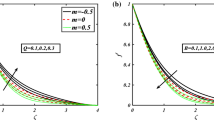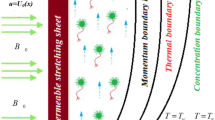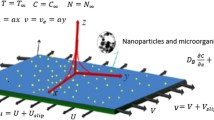Abstract
This article deals with a study of Arrhenius activation energy on thermo-bioconvection nanofluid propagates through a Riga plate. The Riga plate is filled with nanofluid and microorganisms suspended in the base fluid. The fluid is electrically conducting with a varying, parallel Lorentz force, which changes exponentially along the vertical direction, due to the lower electrical conductivity of the base fluid and the arrangements of the electric and magnetic fields at the lower plate. We consider only the electromagnetic body force over a Riga plate. The governing equations are formulated including the activation energy and viscous dissipation effects. Numerical results are obtained through the use of shooting method and are depicted graphically. It is noticed from the results that the magnetic field and the bioconvection Rayleigh number weaken the velocity profile. The bioconvection Schmidt and the Peclet number decrease the microorganism profile. The concentration profile is enhanced due to the increment in activation energy and the Brownian motion tends to increase the temperature profile. The latter is suppressed by an increment of the Prandtl number.












Similar content being viewed by others
Abbreviations
- \({\mathbf{\overset{\lower0.5em\hbox{$\smash{\scriptscriptstyle\smile}$}}{V} }}\) :
-
Velocity vector (m s−1)
- \(\overset{\lower0.5em\hbox{$\smash{\scriptscriptstyle\smile}$}}{p}\) :
-
Pressure (pa)
- \(N_{\text{t}}\) :
-
Thermophoresis parameter
- \(L_{\text{b}}\) :
-
Traditional Lewis number
- \(\tilde{T}\) :
-
Temperature of the fluid (K)
- \(T_{1}\) :
-
Reference temperature (K)
- \(\Theta\) :
-
Average volume of a microorganism
- \(\tilde{t}\) :
-
Time (T)
- \(\tilde{C}_{0}\) :
-
Nanoparticle concentration
- \({\mathbf{g}}\) :
-
Gravity vector (m s−2)
- \(\mu\) :
-
Viscosity (Pa s)
- \(\beta\) :
-
Volumetric coefficient of thermal expansion
- \(\tilde{n}\) :
-
Concentration of microorganisms
- \(M_{0}\) :
-
Magnetization of the permanent magnets
- \(a\) :
-
Width of electrodes and magnets
- \(E_{\text{k}}\) :
-
Eckert number
- \(P_{\text{r}}\) :
-
Prandtl number
- \(R_{\text{b}}\) :
-
Bioconvection Rayleigh number
- \(R_{\text{m}}\) :
-
Basic-density Rayleigh number
- \(P_{\text{e}}\) :
-
Peclet number
- \(\omega\) :
-
Chemical reaction parameter
- \(A\) :
-
Activation energy
- \(\overline{H} \left( {\tilde{C}} \right)\) :
-
Heaviside step function
- \(\bar{b},W_{\text{mo}}\) :
-
Chemotaxis constant
- F :
-
Lorentz force
- \(D_{\text{mo}}\) :
-
Diffusivity of microorganisms
- \(k\) :
-
Boltzmann constant (eV K−1)
- \(E_{\text{a}}\) :
-
Activation energy
- \(K_{\text{r}}^{2}\) :
-
Chemical reaction rate constant
- \(S_{\text{b}}\) :
-
Bioconvection Schmidt number
- \(R_{\text{d}}\) :
-
Radiation parameter
- \(k_{\text{f}}\) :
-
Thermal conductivity (W m−1 K−1)
- \(d_{\text{T}}\) :
-
Thermophoretic diffusion
- \(d_{\text{B}}\) :
-
Brownian motion parameter
- \(J_{0}\) :
-
Current density (A m−2)
- R a :
-
Thermal Rayleigh number
- S c :
-
Schmidt number
- R n :
-
Nanoparticle concentration number
- N b :
-
Brownian motion parameter
- \({\varvec{\upchi}}\) :
-
Flux of microorganisms
- \(\Gamma\) :
-
Temperature difference
- \(\rho\) :
-
Density (kg m3)
- \(\mu\) :
-
Viscosity (N s m−1)
- f, p:
-
Base fluid and nanoparticles
References
Fan X, Chen H, Ding Y, Plucinski PK, Lapkin AA. Potential of ‘nanofluids’ to further intensify microreactors. Green Chem. 2008;10:670.
Li H, Liu S, Dai Z, Bao J, Yang X. Applications of nanomaterials in electrochemical enzyme biosensors. Sensors. 2009;9:8547.
Ebrahimi S, Sabbaghzadeh J, Lajevardi M, Hadi I. Cooling performance of a microchannel heat sink with nanofluids containing cylindrical nanoparticles (carbon nanotubes). Heat Mass Transf. 2010;46:549.
Huh D, Matthews BD, Mammoto A, Montoya-Zavala M, Hsin HY, Ingber DE. Reconstituting organ-level lung functions on a chip. Science. 2010;328:1662.
Do KH, Jang SP. Effect of nanofluids on the thermal performance of a flat micro heat pipe with a rectangular grooved wick. Int J Heat Mass Transf. 2010;53:2183.
Bashirnezhad K, Bazri S, Safaei MR, Goodarzi M, Dahari M, Mahian O, Dalkılıça AS, Wongwises S. Viscosity of nanofluids: a review of recent experimental studies. Int Commun Heat Mass Transf. 2016;73:114.
Michaelides EE. Transport properties of nanofluids. A critical review. J Non-Equilib Thermodyn. 2013;38:1.
Ayub M, Abbas T, Bhatti MM. Inspiration of slip effects on electromagnetohydrodynamics (EMHD) nanofluid flow through a horizontal Riga plate. Eur Phys J Plus. 2016;131:193.
Souayeh B, Kumar KG, Reddy MG, Rani S, Hdhiri N, Alfannakh H, Rahimi-Gorji M. Slip flow and radiative heat transfer behavior of Titanium alloy and ferromagnetic nanoparticles along with suspension of dusty fluid. J Mol Liq. 2019;290:111223.
Uddin S, Mohamad M, Rahimi-Gorji M, Roslan R, Alarifi IM. Fractional electro-magneto transport of blood modeled with magnetic particles in cylindrical tube without singular kernel. Microsyst Technol. 2020;26:405.
Saif RS, Muhammad T, Sadia H, Ellahi R. Hydromagnetic flow of Jeffrey nanofluid due to a curved stretching surface. Physica A. 2020;13:124060.
Alamri SZ, Ellahi R, Shehzad N, Zeeshan A. Convective radiative plane Poiseuille flow of nanofluid through porous medium with slip: an application of Stefan blowing. J Mol Liq. 2019;273:292.
Akermi M, Jaballah N, Alarifi IM, Rahimi-Gorji M, Chaabane RB, Ouada HB, Majdoub M. Synthesis and characterization of a novel hydride polymer P-DSBT/ZnO nano-composite for optoelectronic applications. J Mol Liq. 2019;287:110963.
Kumar KG, Rahimi-Gorji M, Reddy MG, Chamkha AJ, Alarifi IM. Enhancement of heat transfer in a convergent/divergent channel by using carbon nanotubes in the presence of a Darcy–Forchheimer medium. Microsyst Technol. 2019;26:323.
Sheikholeslami M, Bhatti MM. Influence of external magnetic source on nanofluid treatment in a porous cavity. J Porous Media. 2019;22:1475.
Szilágyi IM, Santala E, Heikkilä M, Kemell M, Nikitin T, Khriachtchev L, Räsänen M, Ritala M, Leskelä M. Thermal study on electrospun polyvinylpyrrolidone/ammonium metatungstate nanofibers: optimising the annealing conditions for obtaining WO3 nanofibers. J Therm Anal Calorim. 2011;105:73.
Jaćimović Ž, Kosović M, Kastratović V, Holló BB, Szécsényi KM, Szilágyi IM, Latinović N, Vojinović-Ješić L, Rodić M. Synthesis and characterization of copper, nickel, cobalt, zinc complexes with 4-nitro-3-pyrazolecarboxylic acid ligand. J Therm Anal Calorim. 2018;133:813.
Justh N, Berke B, László K, Szilágyi IM. Thermal analysis of the improved Hummers’ synthesis of graphene oxide. J Therm Anal Calorim. 2018;131:2267.
Holló BB, Ristić I, Budinski-Simendić J, Cakić S, Szilágyi IM, Szécsényi KM. Synthesis, spectroscopic and thermal characterization of new metal-containing isocyanate-based polymers. J Therm Anal Calorim. 2018;132:215.
Sokolov A, Goldstein RE, Feldchtein FI, Aranson IS. Enhanced mixing and spatial instability in concentrated bacterial suspensions. Phys Rev E. 2009;80:031903.
Tsai TH, Liou DS, Kuo LS, Chen PH. Rapid mixing between ferro-nanofluid and water in a semi-active Y-type micromixer. Sens Actuators A Phys. 2009;153:267.
Shitanda I, Yoshida Y, Tatsuma T. Microimaging of algal bioconvection by scanning electrochemical microscopy. Anal Chem. 2007;79:4237.
Iqbal Z, Mehmood Z, Azhar E, Maraj EN. Numerical investigation of nanofluidic transport of gyrotactic microorganisms submerged in water towards Riga plate. J Mol Liq. 2017;234:296.
Balla CS, Ramesh A, Kishan N, Rashad AM, Abdelrahman ZM. Bioconvection in oxytactic microorganism-saturated porous square enclosure with thermal radiation impact. J Therm Anal Calorim. 2019. https://doi.org/10.1007/s10973-019-09009-7.
Shahid A, Zhou Z, Hassan M, Bhatti MM. Computational study of magnetized blood flow in the presence of Gyrotactic microorganisms propelled through a permeable capillary in a stretching motion. Int J Multiscale Comput Eng. 2018;16:409.
Pal D, Mondal SK. Magneto-bioconvection of Powell Eyring nanofluid over a permeable vertical stretching sheet due to gyrotactic microorganisms in the presence of nonlinear thermal radiation and Joule heating. Int J Ambient Energy. 2019. https://doi.org/10.1080/01430750.2019.1679253.
Kumar PS, Gireesha BJ, Mahanthesh B, Chamkha AJ. Thermal analysis of nanofluid flow containing gyrotactic microorganisms in bioconvection and second-order slip with convective condition. J Therm Anal Calorim. 2019;136:1947.
Waqas H, Khan SU, Hassan M, Bhatti MM, Imran M. Analysis on the bioconvection flow of modified second-grade nanofluid containing gyrotactic microorganisms and nanoparticles. J Mol Liq. 2019;1(291):111231.
Lu D, Ramzan M, Ullah N, Chung JD, Farooq U. A numerical treatment of radiative nanofluid 3D flow containing gyrotactic microorganism with anisotropic slip, binary chemical reaction and activation energy. Sci Rep. 2017;7:17008.
Hayat T, Farooq S, Ahmad B, Alsaedi A. Consequences of variable thermal conductivity and activation energy on peristalsis in curved configuration. J Mol Liq. 2018;263:258.
Waqas H, Khan SU, Shehzad SA, Imran M. Significance of the nonlinear radiative flow of micropolar nanoparticles over porous surface with a gyrotactic microorganism, activation energy, and Nield’s condition. Heat Transf Asian Res. 2019;48:3230.
Khan MI, Haq F, Hayat T, Alsaedi A, Rahman MU. Natural bio-convective flow of Sisko nanofluid subject to gyrotactic microorganisms and activation energy. Phys Scr. 2019;94:125203.
Alwatban AM, Khan SU, Waqas H, Tlili I. Interaction of Wu’s slip features in bioconvection of Eyring Powell nanoparticles with activation energy. Processes. 2019;7:859.
Naz S, Gulzar MM, Waqas M, Hayat T, Alsaedi A. Numerical modeling and analysis of non-Newtonian nanofluid featuring activation energy. Appl Nanosci. 2019. https://doi.org/10.1007/s13204-019-01145-8.
Khan SU, Waqas H, Bhatti MM, Imran M. Bioconvection in the rheology of magnetized couple stress nanofluid featuring activation energy and Wu’s slip. J Non-Equilib Thermodyn. 2020;45:81.
Marin M, Nicaise S. Existence and stability results for thermoelastic dipolar bodies with double porosity. Contin Mech Therm. 2016;28:1645.
Marin M, Ellahi R, Chirilă A. On solutions of Saint-Venant’s problem for elastic dipolar bodies with voids. Carpathian J Math. 2017;33:219.
Marin M, Vlase S, Ellahi R, Bhatti MM. On the partition of energies for the backward in time problem of thermoelastic materials with a dipolar structure. Symmetry. 2019;11:863.
Asadollahi A, Rashidi S, Mohamad AA. Removal of the liquid from a micro-object and controlling the surface wettability by using a rotating shell-numerical simulation by lattice-Boltzmann method. J Mol Liq. 2018;272:645.
Michaelides EE. Thermodynamic properties. In: Michaelides EE (Ed) Nanofluidics—thermodynamics and transport properties. Springer, Cham; 2014. pp. 91–115.
Michaelides EE. Brownian movement and thermophoresis of nanoparticles in liquids. Int J Heat Mass Transf. 2015;81:179.
Michaelides EE. Wall effects on the Brownian movement, thermophoresis, and deposition of nanoparticles in liquids. J Fluids Eng. 2016;138:051303.
Author information
Authors and Affiliations
Corresponding author
Additional information
Publisher's Note
Springer Nature remains neutral with regard to jurisdictional claims in published maps and institutional affiliations.
Rights and permissions
About this article
Cite this article
Bhatti, M.M., Michaelides, E.E. Study of Arrhenius activation energy on the thermo-bioconvection nanofluid flow over a Riga plate. J Therm Anal Calorim 143, 2029–2038 (2021). https://doi.org/10.1007/s10973-020-09492-3
Received:
Accepted:
Published:
Issue Date:
DOI: https://doi.org/10.1007/s10973-020-09492-3




